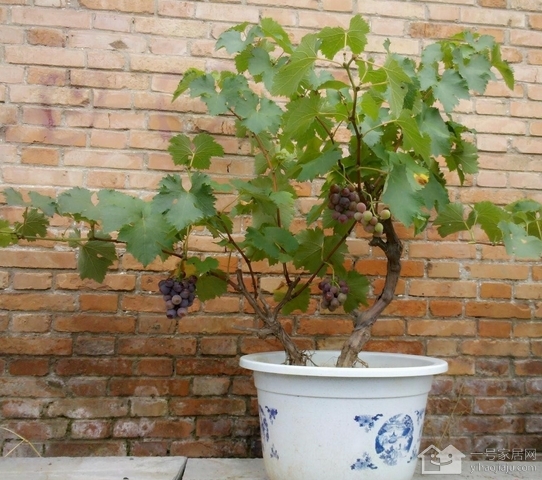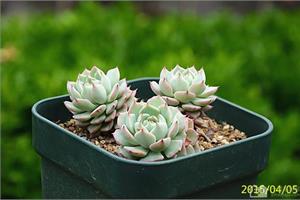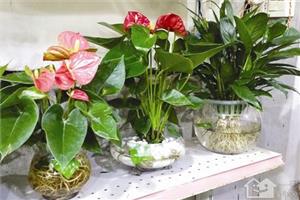Pot and soil change techniques for potted grapes Fertilizer and Water Management of potted Grape
Potted grapes are actually cultivated in containers such as pots, boxes, buckets and planting troughs. This kind of cultivation is very ingenious, and many people want to try it. Let's learn about the techniques of potted grapes on pots and soil change, and the fertilizer and water management of potted grapes.

I. preparation of containers and basin soil
1. Container
Available containers are tile pots, pottery pots, purple sand pots, wooden pots, plastic flowerpots and so on, which can be selected according to the conditions. Potted grapes can use containers with a pot mouth diameter of about 20-25cm in the first year, and 30-40cm containers with a pot mouth diameter after 3 years. It can be determined according to production capacity and site space.
2. Preparation of basin soil
1. Basin soil requirements
Loam which is loose, fertile and rich in organic matter and calcium is required. Local materials can also be used according to the specific conditions of various places, and culture materials with a wide range of sources, low cost, no diseases and insects and no pollution can be selected. The commonly used materials are rotten leaf soil, peat soil, pastoral soil, sand and gravel, bone meal, expanded chicken manure and so on.
2. Preparation and disinfection of potted soil
The commonly used formulations are 4 parts of ① rotten leaf soil, 3 parts of garden soil, 3 parts of coarse sand, 0.5 part of bone meal, 7 parts of ② pastoral soil, 2 parts of coarse sand (or slag), 1 part of expanded chicken manure and 0.5 part of bone meal. After mixing the basin soil, spray it evenly with 0.1% formalin solution (500 ml per cubic meter of basin soil). Then seal it with plastic film, fumigate for one day and night, remove the film, dry it for 4 days, and then put it into a basin.
2. Suitable varieties
The grape varieties available for pot cultivation are Jufeng, Jingya, Jingchao, Idou Jin, Heolin, Jingyu, Fenghuang 51, Tilawa, 8611, 8612, Zizhenxiang, American Heidi and so on.
Third, basin and soil exchange
After the flowerpot is selected, it is best to soak it in 1% bleach water for 5 minutes, take it out and dry it, and then load it into the sterilized culture soil. Seedlings used in potted grapes can be directly cut into seedlings by cuttings in flowerpots. When inserting, it is best to insert 2 cuttings in each basin in order to choose to stay, and always keep the soil in the basin moist. Grape plants of 1-3 years old can also be transplanted with soil masses before sprouting. When transplanting, the branches of the plant should be re-cut, generally leaving 1 Mel 3 strong vines. Transplanting that year, the focus is to restore the tree potential, cultivate the tree shape, lay a good foundation, do not bear fruit first.
After the plant grew in the basin for 2 years, the original container space could not meet the requirements of root growth and development, and the nutrients of the basin soil gradually decreased. Therefore, the container needs to be changed from small to large or the basin soil needs to be replaced. This work is generally carried out before the dormancy period is about to end and before the growth begins. When changing the basin or soil, part of the withered roots should be cut off and watered immediately after the change, so as to facilitate the restoration of plant growth.
IV. Plastic surgery
In general, there are two types of pot grape shaping:
1. Single rod shape
Suitable for small and medium-sized potted plants, when planted, stand a bamboo pole or No. 8 iron wire in the middle of the pot, about 1m high. After the new shoots germinated, a strong shoot was selected as the main vine, which was tied to the bamboo pole and picked out when it grew to 80-90cm. After that, except for the top one, the other two leaves were left to pick the heart repeatedly. The branches that mature well during winter pruning can be cut to retain 50cm. After germination in the second year, 5 robust shoots were left on the main vine, and the rest of the buds should be erased in time. During winter pruning, 3 buds of each new shoot were left to be pruned as fruit mother branches. After sprouting in the third year, two new shoots were left for each fruiting mother branch, and then cut every year.
2. Sector shape
In the winter of the same year, the pruning of new shoots above 60cm was reserved as the trunk, and in the next year, one new shoot was tilted and tied every other 10-15cm, and in winter shearing, it was a fruiting mother branch with three buds, and in the third year, two fruiting branches were left on each fruiting mother branch. The new shoots and fruit ears were evenly distributed in one plane, and the flowerpot and fan were enlarged with the increase of tree body.
5. Fertilizer and water management
1. Fertilization
The principle of fertilization for potted grapes is to apply sparsely and diligently. The pot seedlings that have not yet borne fruit generally start from the seedling height of about 20cm (that is, 6 Mel 7 leaves) and apply cake fertilizer and water once every 7 Mel 10 days until the end of September. For the fruited potted grapes, it is best to apply them every 5 days in order to ensure the fruit development. After the fruit is harvested, it is applied according to the pot seedling. Pay attention to watering immediately after each application of liquid fertilizer. Foliar fertilizer spraying can also be carried out by spraying 0.1% Mel 0.3% urea solution 2Mel 3 times in the early growth stage of potted grapes; starting from the fruit expansion period, 0.3% KH 2H 2PO 4 solution can be sprayed 4 times every 10 days.
When applied, there are two types of base fertilizer and topdressing. (1) Base fertilizer is suitable to be applied before and after the National Day, mainly mature farm manure. (2) manure and urine are the most suitable topdressing, and urea, ammonium sulfate, ammonium bicarbonate, potassium sulfate and calcium superphosphate can also be applied in three stages. 1. Sprout fertilizer. For the plants with many fruits and weak tree potential, the application at the time of bud expansion is beneficial to the development of juniper. Mainly human feces and urine, should not be applied too late, should be applied 30-40 days before flowering. 2. Fat after flowering. The application from flower fade to young fruit expansion stage can promote fruit expansion and facilitate flower bud differentiation of new shoots. It is a necessary fertilizer. Mainly nitrogen, properly mixed with phosphorus and potassium fertilizer. Each plant was mixed with 250 grams of calcium superphosphate and 50 grams of potassium sulfate. 3.Fruit fertilizer. It was applied 20 days before fruit harvest, mainly phosphorus and potassium in early July, with a small amount of nitrogen fertilizer, 250 grams of calcium superphosphate and 100 grams of potassium sulfate per plant, adding amine sulfate and urea to irrigate or dissolve in water.
2. Watering
When watering, the water temperature had better be close to the basin soil temperature, and it is appropriate to water before 10:00 or after 4 p.m.; the water quality is good, and the watering times should depend on the season. Generally, the temperature in early spring is low, and it can be watered every 3 days. As the air temperature increases, evaporation increases, it can be watered once every 2 days. After the temperature gradually decreases in autumn, the watering times gradually become less, and the basin soil is moist.
VI. Pest control
Potted grape has less insect pests, and the focus is on diseases. Common diseases are downy mildew, white rot, anthrax, black pox and so on.
The grape can be sprayed with stone sulfur mixture of 3mur5 Baume during the dormancy period. After germination, Bordeaux solution of 0.5% Bordeaux solution or 500 times compound carbendazim solution is sprayed every 10 mures and 15 days, and the general disease can be prevented and controlled.
The above is the relevant introduction of this article, I believe you have a simple understanding of this after reading it, if necessary, you can continue to pay attention to the No. 1 home network for more information.
- Prev

What is the effect and function of succulent plants seen by succulent fans
What is the effect and function of succulent plants seen by succulent fans
- Next

If plants have pests, it doesn't matter to teach you all kinds of convenient life insecticidal methods.
If plants have pests, it doesn't matter to teach you all kinds of convenient life insecticidal methods.
Related
- Wuhan Hospital Iron Tree Blooming Result Was Instantly Frightened by the Gardener Master
- Which variety of camellia is the most fragrant and best? Which one do you like best?
- What is the small blue coat, the breeding methods and matters needing attention of the succulent plant
- Dormancy time and maintenance management of succulent plants during dormancy
- Minas succulent how to raise, Minas succulent plant pictures
- What are the varieties of winter succulent plants
- How to raise succulent plants in twelve rolls? let's take a look at some experience of breeding twelve rolls.
- Attention should be paid to water control for succulent plants during dormant period (winter and summer)
- Watering experience of twelve rolls of succulent plants
- Techniques for fertilizing succulent plants. An article will let you know how to fertilize succulent plants.

